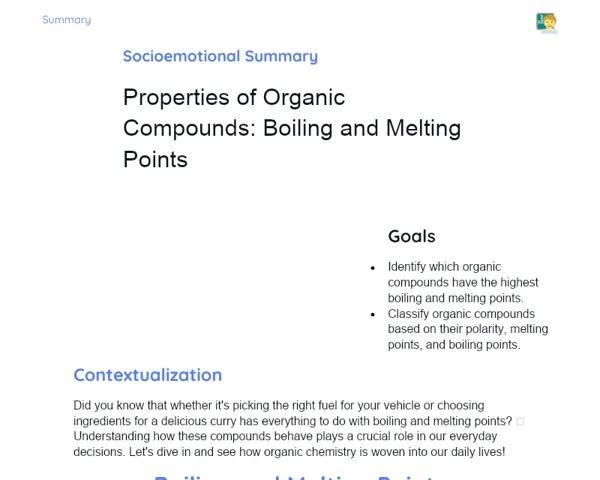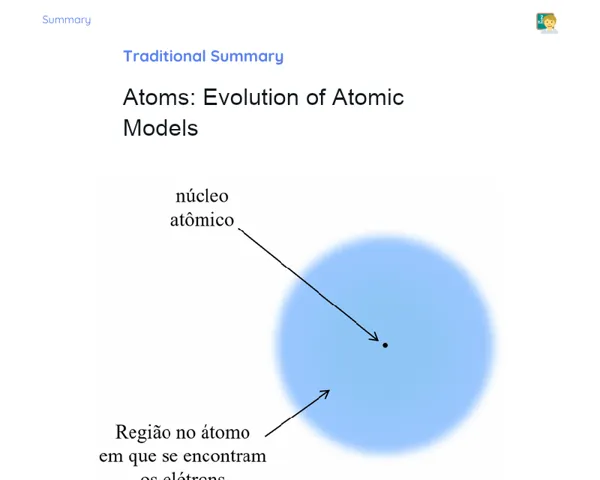Socioemotional Summary Conclusion
Goals
1. 🔍 Understand the concept of electronic distribution and its significance in atomic structure.
2. 🔬 Identify and perform the electronic distribution of atoms and ions, including those with unusual distributions.
3. 📝 Enhance teamwork and communication skills through practical exercises.
Contextualization
✨ Did you know that the arrangement of electrons around an atom's nucleus can significantly impact the chemical behaviour of that element? It's akin to each electron playing a specific role, and when they are in sync, the 'dance' of the electrons leads to intriguing chemical reactions. Let's explore how this electronic distribution mirrors our own journey for emotional balance and functionality in our day-to-day lives. 🌟⚛️
Exercising Your Knowledge
Understanding Atoms and Atomic Structure
🔬 An atom is the smallest unit of matter that retains the characteristics of a chemical element. It consists of a nucleus housing protons and neutrons, and an electron cloud surrounding it, where electrons orbit the nucleus. Grasping this structure is crucial for learning about electronic distribution, as it is within the electron cloud that electrons are organized into energy levels.
-
✔️ Nucleus: Contains protons (positive charge) and neutrons (neutral charge). The number of protons defines the element.
-
✔️ Electron Cloud: The area surrounding the nucleus where negatively charged electrons are located. The distribution of these electrons follows specific rules, which we will explore later.
-
✔️ Importance of Understanding Atomic Structure: It's essential to comprehend atomic structure to understand how different elements interact and react with one another.
Energy Levels and Sublevels
⚡ Electrons in an atom occupy various energy levels as they move away from the nucleus. Each energy level can be divided into sublevels (s, p, d, f), with each sublevel containing specific orbitals that house the electrons. Grasping this distribution is critical to accurately performing electronic distributions.
-
✨ Energy Levels: Each energy level is marked by a principal quantum number (n=1, n=2, etc.). Energy levels closest to the nucleus have lower energy.
-
🚀 Sublevels (s, p, d, f): Each energy level breaks down into sublevels. For instance, the first energy level has only one sublevel, 's', while the second level has 's' and 'p'.
-
🔄 Orbitals: These are areas around the nucleus where electrons are most likely found. Each sublevel has a specific number of orbitals. For example, the 's' sublevel accommodates 1 orbital, while 'p' contains 3 orbitals.
Principles Governing Electronic Distribution
📘 To accurately distribute electrons in atomic orbitals, we adhere to three fundamental principles: the Pauli Exclusion Principle, the Aufbau Principle, and Hund's Rule. These principles ensure that electrons are arranged in a manner that permits the atom to achieve its lowest energy state.
-
🔑 Pauli Exclusion Principle: Each orbital can hold a maximum of two electrons with opposite spins, ensuring that no more than two electrons occupy the same quantum state.
-
📈 Aufbau Principle: Electrons fill lower energy orbitals before progressing to higher ones. Thus, energy levels and sublevels closest to the nucleus are filled primarily.
-
🎯 Hund's Rule: For sublevels containing more than one orbital (like p, d, f), electrons are distributed among the orbitals to maximise the number of unpaired electrons with the same spin before they start pairing.
Key Terms
-
⚛️ Atom: The smallest unit of matter retaining the characteristics of a chemical element.
-
🔋 Energy Levels: Shells in the electron cloud that hold electrons with varying energy amounts.
-
⊗ Sublevels (s, p, d, f): Divisions within energy levels containing specific numbers of orbitals.
-
🔄 Orbitals: Regions around the nucleus where electrons are most likely found.
-
🔑 Pauli Exclusion Principle: Each orbital may hold a maximum of two electrons with opposite spins.
-
📈 Aufbau Principle: Electrons occupy lower energy orbitals before moving on to higher energy orbitals.
-
🎯 Hund's Rule: Within a sublevel, electrons fill empty orbitals first to maximise unpaired electrons.
For Reflection
-
🤔 How do you feel when tackling a new and intricate concept like electronic distribution? What approaches help you stay calm and focused?
-
💬 Did working in groups aid or hinder your understanding during the lesson? What interpersonal skills do you think need development?
-
🌟 Recall a time you had to find equilibrium in a challenging situation, akin to how electrons find their energy levels. How can that experience inform your understanding of electronic distribution?
Important Conclusions
-
🔍 Electronic distribution is crucial for comprehending the structure and behaviour of atoms.
-
📚 We explored the principles of Pauli, Aufbau, and Hund, which direct the arrangement of electrons in orbitals.
-
🌟 We identified and executed electronic distributions, including atypical ones, applying theory to practice.
-
🤝 We worked collaboratively in groups, honing our communication and teamwork skills, which are invaluable in both academic settings and life.
Impacts on Society
Understanding electronic distribution is not merely an academic exercise; it has real-world applications in several technologies we use daily, such as electronic devices. For instance, comprehending electron behaviour in semiconductor materials is vital for crafting computer chips and smartphones. Each time you utilise an application or send a message, you're leveraging theoretical principles of electronic distribution.
On a personal and emotional level, delving into electronic distribution can metaphorically guide us in our quest for balance in life. Just as electrons locate their optimal orbits for the smooth functioning of an atom, we too need to identify our positions and emotional balance to operate effectively and joyfully. Recognising this parallel can empower us to better manage our emotional and social hurdles.
Dealing with Emotions
To effectively navigate emotions while studying electronic distribution and its real-life implications, I suggest employing the RULER method. First, recognise the emotions that arise when faced with studying challenges; take a moment to reflect on what you feel. Then, attempt to understand the source of these emotions and their effect on your performance. Accurately label these emotions: anxiety, curiosity, frustration, etc. Express these emotions constructively, whether that means discussing them with a friend or jotting them down in a journal. Finally, practice emotional regulation strategies, such as the deep breathing exercises we did in class or a quick meditation. This practice will aid in maintaining focus and composure while studying.
Study Tips
-
🎯 Create Mind Maps: Sketch diagrams to visualise the hierarchy of energy levels and sublevels. This method helps you organise your thoughts and enhances memory retention.
-
📅 Organise Study Sessions: Divide the content into smaller sections and study a little each day. Regular intervals are beneficial in sustaining focus and assimilating knowledge.
-
💬 Collaborate in Groups: Studying with peers can clarify doubts and strengthen understanding, while developing your communication and teamwork skills.



